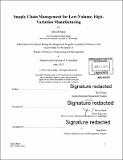| dc.contributor.advisor | Steven Spear. | en_US |
| dc.contributor.author | Parry, David (David Michael) | en_US |
| dc.contributor.other | System Design and Management Program. | en_US |
| dc.date.accessioned | 2017-10-30T15:30:03Z | |
| dc.date.available | 2017-10-30T15:30:03Z | |
| dc.date.copyright | 2017 | en_US |
| dc.date.issued | 2017 | en_US |
| dc.identifier.uri | http://hdl.handle.net/1721.1/112067 | |
| dc.description | Thesis: S.M. in Engineering and Management, Massachusetts Institute of Technology, School of Engineering, System Design and Management Program, 2017. | en_US |
| dc.description | Cataloged from PDF version of thesis. | en_US |
| dc.description | Includes bibliographical references (page 64). | en_US |
| dc.description.abstract | This thesis introduces a low-volume, high variation manufacturing company that is experiencing issues managing its supply chain. Issues include lack of process ownership, poor requirements flow down to vendors, and an ineffective supplier selection process. This example uses a systematic approach for addressing re-occurring problems related to supply chain management. The premise underlying the approach exemplifies that modem process improvement techniques such a Lean Manufacturing boast large efficiency gains in operations, but fail to address pre-operation process issues such as supplier selection based on capability alignment. By breaking down the current condition, issues within the current process and their associated root causes were identified. These included: inadequate internal processes, lack of access to information on supplier capabilities, and responsibility ambiguity. Corrective actions and countermeasures to these root causes such as: defined roles for the supplier selection process; a Supplier Capability Matrix; and internal requirements for supplier selection serve as a basis for a redesigned process. This results in a target condition that differs from the current in organizational structure, internal process requirements for supplier selection, and fewer non-conformance identified at incoming inspection. This thesis also provides a proposal for transitioning towards the target condition via an incremental implementation. This process utilizes the scientific method as a methodology for incorporating new processes, and to validate their effectiveness on the overall system in a step by step fashion. Verification of improvement can serve as a business case for additional change and implementation. This case study of a small electronics manufacturing company demonstrates the method in practical application. Results suggest that application is best suited for organizations that are looking to optimize their supply chain by reducing the risk of receiving non-conforming, or unusable material from their suppliers. The approach for identifying process issues, determining root causes, and implementing countermeasures provides a robust example for process improvement efforts. | en_US |
| dc.description.statementofresponsibility | by David Parry. | en_US |
| dc.format.extent | 64 pages | en_US |
| dc.language.iso | eng | en_US |
| dc.publisher | Massachusetts Institute of Technology | en_US |
| dc.rights | MIT theses are protected by copyright. They may be viewed, downloaded, or printed from this source but further reproduction or distribution in any format is prohibited without written permission. | en_US |
| dc.rights.uri | http://dspace.mit.edu/handle/1721.1/7582 | en_US |
| dc.subject | Engineering and Management Program. | en_US |
| dc.subject | System Design and Management Program. | en_US |
| dc.title | Supply chain management for low-volume, high-variation manufacturing | en_US |
| dc.type | Thesis | en_US |
| dc.description.degree | S.M. in Engineering and Management | en_US |
| dc.contributor.department | Massachusetts Institute of Technology. Engineering and Management Program | en_US |
| dc.contributor.department | System Design and Management Program. | en_US |
| dc.identifier.oclc | 1006734849 | en_US |
